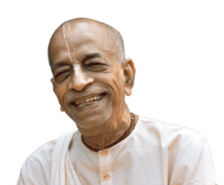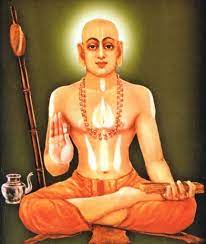

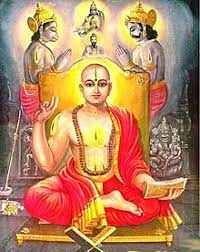
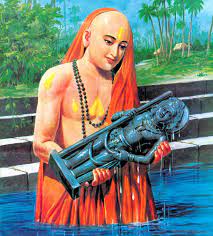
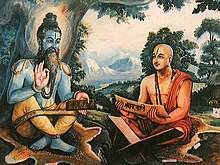

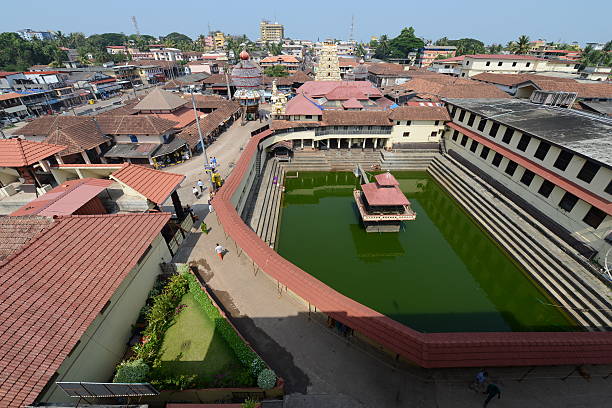
Srila Prabhupada re Madhvacarya

The specific mention of Draviḍa-deśa refers to the five Draviḍa-deśas in South India. All are very strong in rendering the preliminary devotional processes (śravaṇaṁ kīrtanam). Some great ācāryas, like Rāmānujācārya and Madhvācārya, also came from Draviḍa-deśa and became great preachers. They were all situated on the platform of sakhyam ātma-nivedanam. [Srimad Bhagavatam 4.28.30 Purport]
madhvācārya-sthāne āilā yāṅhā ‘tattvavādī’
uḍupīte ‘kṛṣṇa’ dekhi, tāhāṅ haila premonmādī
SYNONYMS
madhva-ācārya-sthāne—at the place of Madhvācārya; āilā—arrived; yāṅhā—where; tattva-vādī—philosophers known as Tattvavādīs; uḍupīte—at the place known as Uḍupī; kṛṣṇa—the Deity of Lord Kṛṣṇa; dekhi—seeing; tāhāṅ—there; haila—became; prema-unmādī—mad in ecstasy.
Caitanya Mahāprabhu next arrived at Uḍupī, the place of Madhvācārya, where the philosophers known as Tattvavādīs resided. There He saw the Deity of Lord Kṛṣṇa and became mad with ecstasy.
PURPORT
Śrīpāda Madhvācārya took his birth at Uḍupī, which is situated in the South Kanaraḍā district of South India, just west of Sahyādri. This is the chief city of the South Kanaraḍā province and is near the city of Mangalore, which is situated to the south of Uḍupī. In the city of Uḍupī is a place called Pājakā-kṣetra, where Madhvācārya took his birth in a Śivāllī-brāhmaṇa dynasty as the son of Madhyageha Bhaṭṭa, in the year 1040 Śakābda (A.D. 1119). According to some, he was born in the year 1160 Śakābda (A.D. 1239).
In his childhood Madhvācārya was known as Vāsudeva, and there are some wonderful stories surrounding him. It is said that once when his father had piled up many debts, Madhvācārya converted tamarind seeds into actual coins to pay them off. When he was five years old, he was offered the sacred thread. A demon named Maṇimān lived near his abode in the form of a snake, and at the age of five Madhvācārya killed that snake with the toe of his left foot. When his mother was very much disturbed, he would appear before her in one jump. He was a great scholar even in childhood, and although his father did not agree, he accepted sannyāsa at the age of twelve. Upon receiving sannyāsa from Acyuta Prekṣa, he received the name Pūrṇaprajña Tīrtha. After traveling all over India, he finally discussed scriptures with Vidyāśaṅkara, the exalted leader of Sṛṅgeri-maṭha. Vidyāśaṅkara was actually diminished in the presence of Madhvācārya. Accompanied by Satya Tīrtha, Madhvācārya went to Badarikāśrama. It was there that he met Vyāsadeva and explained his commentary on the Bhagavad-gītā before him. Thus, he became a great scholar by studying before Vyāsadeva.
By the time he came to the Ānanda-maṭha from Badarikāśrama, Madhvācārya had finished his commentary on the Bhagavad-gītā. His companion Satya Tīrtha wrote down the entire commentary. When Madhvācārya returned from Badarikāśrama, he went to Gañjāma, which is on the bank of the river Godāvarī. There he met with two learned scholars named Śobhana Bhaṭṭa and Svāmī Śāstrī. Later these scholars became known in the disciplic succession of Madhvācārya as Padmanābha Tīrtha and Narahari Tīrtha. When he returned to Uḍupī, he would sometimes bathe in the ocean. On such an occasion he composed a prayer in five chapters. Once, while sitting beside the sea engrossed in meditation upon Lord Śrī Kṛṣṇa, he saw that a large boat containing goods for Dvārakā was in danger. He gave some signs by which the boat could approach the shore, and it was saved. The owners of the boat wanted to give him a present, and at the time Madhvācārya agreed to take some gopī-candana. He received a big lump of gopī-candana, and as it was being brought to him, it broke apart and revealed a large Deity of Lord Kṛṣṇa. The Deity had a stick in one hand and a lump of food in the other. As soon as Madhvācārya received the Deity of Kṛṣṇa in this way, he composed a prayer. The Deity was so heavy that not even thirty people could lift it. Madhvācārya personally brought this Deity to Uḍupī. Madhvācārya had eight disciples, all of whom took sannyāsa from him and became directors of his eight monasteries. Worship of the Lord Kṛṣṇa Deity is still going on at Uḍupī according to the plans Madhvācārya established.
Madhvācārya then for the second time visited Badarikāśrama. While he was passing through Maharashtra, the local king was digging a big lake for the public benefit. As Madhvācārya passed through that area with his disciples, he was also obliged to help in the excavation. After some time, when Madhvācārya visited the king, he engaged the king in that work and departed with his disciples.
Often in the province of Gāṅga-pradeśa there were fights between Hindus and Muslims. The Hindus were on one bank of the river, and the Muslims on the other. Due to the community tension, no boat was available for crossing the river. The Muslim soldiers were always stopping passengers on the other side, but Madhvācārya did not care for these soldiers. He crossed the river anyway, and when he met the soldiers on the other side, he was brought before the king. The Muslim king was so pleased with him that he wanted to give him a kingdom and some money, but Madhvācārya refused. While walking on the road, he was attacked by some dacoits, but by his bodily strength he killed them all. When his companion Satya Tīrtha was attacked by a tiger, Madhvācārya separated them by virtue of his great strength. When he met Vyāsadeva, he received from him the śālagrāma-śilā known as Aṣṭamūrti. After this, he summarized the Mahābhārata.
Madhvācārya’s devotion to the Lord and his erudite scholarship became known throughout India.
Consequently, the owners of the Śṛṅgeri-maṭha, established by Śaṅkarācārya, became a little perturbed. At that time the followers of Śaṅkarācārya were afraid of Madhvācārya’s rising power, and they began to tease Madhvācārya’s disciples in many ways. There was even an attempt to prove that the disciplic succession of Madhvācārya was not in line with Vedic principles. A person named Puṇḍarīka Purī, a follower of the Māyāvāda philosophy of Śaṅkarācārya, came before Madhvācārya to discuss the śāstras. It is said that all of Madhvācārya’s books were taken away, but later they were found with the help of King Jayasiṁha, ruler of Kumla. In discussion, Puṇḍarīka Purī was defeated by Madhvācārya. A great personality named Trivikramācārya, who was a resident of Viṣṇumaṅgala, became Madhvācārya’s disciple, and his son later became Nārāyaṇācārya, the composer of Śrī Madhva-vijaya. After the death of Trivikramācārya, the younger brother of Nārāyaṇācārya took sannyāsa and later became known as Viṣṇu Tīrtha.
It was reputed that there was no limit to the bodily strength of Pūrṇaprajña, Madhvācārya. There was a person named Kaḍañjari who was famed for possessing the strength of thirty men. Madhvācārya placed the big toe of his foot upon the ground and asked the man to separate it from the ground, but the great strong man could not do so even after great effort. Śrīla Madhvācārya passed from this material world at the age of eighty while writing a commentary on the Aitareya Upaniṣad. For further information about Madhvācārya, one should read Madhva-vijaya, by Nārāyaṇācārya.
The ācāryas of the Madhva-sampradāya established Uḍupī as the chief center, and the monastery there was known as Uttararāḍhī-maṭha. A list of the different centers of the Madhvācārya-sampradāya can be found at Uḍupī, and their maṭha commanders are (1) Viṣṇu Tīrtha (Śoda-maṭha), (2) Janārdana Tīrtha (Kṛṣṇapura-maṭha), (3) Vāmana Tīrtha (Kanura-maṭha), (4) NarasiṁhaTīrtha (Adamara-maṭha), (5) Upendra Tīrtha (Puttugī-maṭha), (6) Rāma Tīrtha (Śirura-maṭha), (7) Hṛṣīkeśa Tīrtha (Palimara-maṭha), and (8) Akṣobhya Tīrtha (Pejāvara-maṭha). The disciplic succession of the Madhvācārya-sampradāya is as follows (the dates are those of birth): (1) Haṁsa Paramātmā; (2) Caturmukha Brahmā; (3) Sanakādi; (4) Durvāsā; (5) Jñānanidhi; (6) Garuḍa-vāhana; (7) Kaivalya Tīrtha; (8) Jñāneśa Tīrtha; (9) Para Tīrtha; (10) Satyaprajña Tīrtha; (11) Prājña Tīrtha; (12) Acyuta Prekṣācārya Tīrtha; (13) Śrī Madhvācārya, 1040 Śaka; (14) Padmanābha, 1120; Narahari, 1127; Mādhava, 1136; and Akṣobhya 1159; (15) Jaya Tīrtha, 1167; (16) Vidyādhirāja, 1190; (17) Kavīndra, 1255; (18) Vāgīśa, 1261; (19) Rāmacandra, 1269; (20) Vidyānidhi, 1298; (21) Śrī Raghunātha, 1366; (22) Rayuvarya (who spoke with Śrī Caitanya Mahāprabhu), 1424; (23) Raghūttama, 1471; (24) Vedavyāsa, 1517; (25) Vidyādhīśa, 1541; (26) Vedanidhi, 1553; (27) Satyavrata, 1557; (28) Satyanidhi, 1560; (29) Satyanātha, 1582; (30) Satyābhinava, 1595; (31) Satyapūrṇa, 1628; (32) Satyavijaya, 1648; (33) Satyapriya, 1659; (34) Satyabodha, 1666; (35) Satyasandha, 1705; (36) Satyavara, 1716; (37) Satyadharma, 1719; (38) Satyasaṅkalpa, 1752; (39) Satyasantuṣṭa, 1763; (40) Satyaparāyaṇa, 1763; (41) Satyakāma, 1785; (42) Satyeṣṭa, 1793; (43) Satyaparākrama, 1794; (44) Satyadhīra, 1801; (45) Satyadhīra Tīrtha, 1808. (For approximate Christian era dates, add seventy-nine years.)
After the sixteenth ācārya (Vidyādhirāja Tīrtha), there was another disciplic succession, including Rājendra Tīrtha, 1254; Vijayadhvaja; Puruṣottama; Subrahmaṇya; and Vyāsa Rāya, 1470-1520.
The nineteenth ācārya, Rāmacandra Tīrtha, had another disciplic succession, including Vibudhendra, 1218; Jitāmitra, 1348; Raghunandana; Surendra; Vijendra; Sudhīndra; and Rāghavendra Tīrtha, 1545.
To date, in the Uḍupī monastery there are another fourteen Madhva-tīrtha sannyāsīs. As stated, Uḍupī is situated beside the sea in South Kanaraḍā, about thirty-six miles north of Mangalore.
Most of the information in this purport is available from the South Kānāḍā Manual and the Bombay Gazette. [Sri Caitanya-Caritamrta Madhya -Lila 9.245]
We should not make any particular distinction between the poor and the rich like the foolish worshipers of daridra-nārāyaṇa. Nārāyaṇa is present in the rich as well as the poor. One should not simply think Nārāyaṇa is situated among the poor. He is everywhere. An advanced devotee will offer respects to everyone—even to cats and dogs.
vidyā-vinaya-sampanne
brāhmaṇe gavi hastini
śuni caiva śva-pāke ca
paṇḍitāḥ sama-darśinaḥ
“The humble sage, by virtue of true knowledge, sees with equal vision a learned and gentle brāhmaṇa, a cow, an elephant, a dog and a dog-eater [outcaste].” (Bg. 5.18) This sama-darśinaḥ, equal vision, should not be mistaken to mean that the individual is the same as the Supreme Lord. They are always distinct. Every individual person is different from the Supreme Lord. It is a mistake to equate the individual living entity with the Supreme Lord on the plea of vivikta-dṛk, sama-dṛk. The Lord is always in an exalted position, even though He agrees to live everywhere. Śrīla Madhvācārya, quoting Padma Purāṇa, states: vivikta-dṛṣṭi jīvānāṁ dhiṣṇyatayā parameśvarasya bheda-dṛṣṭiḥ. “One who has clear vision and who is devoid of envy can see that the Supreme Lord is separate from all living entities, although He is situated in every living entity.” Madhvācārya further quotes from Padma Purāṇa:
upapādayet parātmānaṁ
jīvebhyo yaḥ pade pade
bhedenaiva na caitasmāt
priyo viṣṇos tu kaścana
“One who sees the living entity and the Supreme Lord as always distinct is very dear to the Lord.” Padma Purāṇa also states, yo hareś caiva jīvānāṁ bheda-vaktā hareḥ priyaḥ: “One who preaches that the living entities are separate from the Supreme Lord is very dear to Lord Viṣṇu.”Srimad-Bhgavatam 5.5.26
asyānuguṇān ślokān gāyanti——
aho bhuvaḥ sapta-samudravatyā
dvīpeṣu varṣeṣv adhipuṇyam etat
gāyanti yatratya-janā murāreḥ
karmāṇi bhadrāṇy avatāravanti
SYNONYMS
tasya—of Him (Lord Ṛṣabhadeva); anuguṇān—conforming to the instructions for liberation; ślokān—verses; gāyanti—chant; aho—oh; bhuvaḥ—of this earthly planet; sapta-samudra-vatyāḥ—possessing seven seas; dvīpeṣu—among the islands; varṣeṣu—among the lands; adhipuṇyam—more pious than any other island; etat—this (Bhārata-varṣa); gāyanti—sing about; yatratya-janāḥ—the people of this tract of land; murāreḥ—of Murāri, the Supreme Personality of Godhead; karmāṇi—the activities; bhadrāṇi—all-auspicious; avatāravanti—in many incarnations such as Lord Ṛṣabhadeva.
TRANSLATION
Learned scholars chant about the transcendental qualities of Lord Ṛṣabhadeva in this way: “Oh, this earthly planet contains seven seas and many islands and lands, of which Bhārata-varṣa is considered the most pious. People of Bhārata-varṣa are accustomed to glorifying the activities of the Supreme Personality of Godhead in His incarnations as Lord Ṛṣabhadeva and others. All these activities are very auspicious for the welfare of humanity.
PURPORT
Śrī Caitanya Mahāprabhu said:
bhārata-bhūmite haila manuṣya-janma yāra
janma sārthaka kari’ kara para-upakāra
[Cc. Ādi 9.41]
As stated in this verse, Bhārata-varṣa is a most pious land. The followers of Vedic literature understand the Supreme Personality of Godhead in His different incarnations, and they are privileged to glorify the Lord by following the directions of Vedic literature. After realizing the glories of human life. such people should take up the mission to spread the importance of human life throughout the whole world. This is the mission of Śrī Caitanya Mahāprabhu. The word adhipuṇyam indicates that there are certainly many other pious men throughout the world, but the people of Bhārata-varṣa are even more pious. Therefore, they are fit to spread Kṛṣṇa Consciousness throughout the world for the benefit of all human society. Śrīla Madhvācārya also recognizes the land of Bhārata-varṣa: viśeṣād bhārate puṇyam. Throughout the world, there is no question of bhagavad-bhakti or devotional service, but the people of Bhārata-varṣa can easily understand the devotional service of the Lord. Thus every inhabitant of Bhārata-varṣa can perfect his life by discharging bhagavad-bhakti and then preaching this cult throughout the world for the benefit of everyone. Srimad-Bhagavatam 5.6.13
Lord Brahmā is the guru of Nārada Muni, who is the guru of Vyāsadeva, and Vyāsadeva is the guru of Madhvācārya. Thus the Gauḍīya-Mādhva-sampradāya is in the disciplic succession from Nārada Muni. The members of this disciplic succession—in other words, the members of the Kṛṣṇa consciousness movement—should follow in the footsteps of Nārada Muni by chanting the transcendental vibration Hare Kṛṣṇa, Hare Kṛṣṇa, Kṛṣṇa Kṛṣṇa, Hare Hare/ Hare Rāma, Hare Rāma, Rāma Rāma, Hare Hare. They should go everywhere to deliver the fallen souls by vibrating the Hare Kṛṣṇa mantra and the instructions of Bhagavad-gītā, Śrīmad-Bhāgavatam and Caitanya-caritāmṛta. That will please the Supreme Personality of Godhead. One can spiritually advance if one actually follows the instructions of Nārada Muni. If one pleases Nārada Muni, then the Supreme Personality of Godhead, Hṛṣīkeśa, is also pleased (yasya prasādād bhagavat-prasādaḥ ). The immediate spiritual master is the representative of Nārada Muni; there is no difference between the instructions of Nārada Muni and those of the present spiritual master. Both Nārada Muni and the present spiritual master speak the same teachings of Kṛṣṇa, who says in Bhagavad-gītā (18.65–66):
man-manā bhava mad-bhakto
mad-yājī māṁ namaskuru
mām evaiṣyasi satyaṁ te
pratijāne priyo ’si me
sarva-dharmān parityajya
mām ekaṁ śaraṇaṁ vraja
ahaṁ tvāṁ sarva-pāpebhyo
mokṣayiṣyāmi mā śucaḥ
“Always think of Me and become My devotee. Worship Me and offer your homage unto Me. Thus, you will come to Me without fail. I promise you this because you are My very dear friend. Abandon all varieties of religion and just surrender unto Me. I shall deliver you from all sinful reaction. Do not fear.” Srimad-Bhagavata, 6.5.22
This verse indicates that oṁkāra, or praṇava, is a direct representation of the Supreme Personality of Godhead. Therefore, if at the time of death one simply remembers oṁkāra, he remembers the Supreme Personality of Godhead and is therefore immediately transferred to the spiritual world. Oṁkāra is the basic principle of all Vedic mantras, for it is a representation of Lord Kṛṣṇa, understanding of whom is the ultimate goal of the Vedas, as stated in the Bhagavad-gītā (vedaiś ca sarvair aham eva vedyaḥ). Māyāvādī philosophers cannot understand these simple facts explained in the Bhagavad-gītā, and yet they are very proud of being Vedāntīs. Sometimes, therefore, we refer to the Vedāntī philosophers as Vidantīs, those who have no teeth (vi means “without,” and dantī means “possessing teeth”). The statements of the Śaṅkara philosophy, which are the teeth of the Māyāvādī philosopher, are always broken by the strong arguments of Vaiṣṇava philosophers such as the great ācāryas, especially Rāmānujācārya. Śrīpāda Rāmānujācārya and Madhvācārya break the teeth of the Māyāvādī philosophers, who can therefore be called Vidantīs, “toothless.”
Sri Caitanya Caritamrta Adi-Lila 7.128
Śrī Mādhavendra Purī is one of the ācāryas in the disciplic succession from Madhvācārya. Mādhavendra Purī had two principal disciples, Īśvara Purī and Śrī Advaita Prabhu. Therefore the Gauḍīya Vaiṣṇava-sampradāya is a disciplic succession from Madhvācārya. This fact has been accepted in the authorized books known as Gaura-gaṇoddeśa-dīpikā and Prameya-ratnāvalī, as well as by Gopāla Guru Gosvāmī. The Gaura-gaṇoddeśa-dīpikā clearly states the disciplic succession of the Gauḍīya Vaiṣṇavas as follows: “Lord Brahmā is the direct disciple of Viṣṇu, the Lord of the spiritual sky. His disciple is Nārada, Nārada’s disciple is Vyāsa, and Vyāsa’s disciples are Śukadeva Gosvāmī and Madhvācārya. Padmanābha Ācārya is the disciple of Madhvācārya, and Narahari is the disciple of Padmanābha Ācārya. Mādhava is the disciple of Narahari, Akṣobhya is the direct disciple of Mādhava, and Jayatīrtha is the disciple of Akṣobhya. Jayatīrtha’s disciple is Jñānasindhu, and his disciple is Mahānidhi. Vidyānidhi is the disciple of Mahānidhi, and Rājendra is the disciple of Vidyānidhi. Jayadharma is the disciple of Rājendra. Puruṣottama is the disciple of Jayadharma. Śrīmān Lakṣmīpati is the disciple of Vyāsatīrtha, who is the disciple of Puruṣottama. And Mādhavendra Purī is the disciple of Lakṣmīpati.” Sri Caitanya Caritamrta Adi-Lila 6.40
The amazing story of Mula-Rama
The Madhvācārya-sampradāya and Rāmānuja-sampradāya are mainly worshipers of Lord Rāmacandra, although the Śrī Vaiṣṇavas are supposed to be worshipers of Lord Nārāyaṇa and Lakṣmī and the Tattvavādīs are supposed to be worshipers of Lord Kṛṣṇa. At present, in most of the monasteries belonging to the Madhva-sampradāya, Lord Rāmacandra is worshiped.
In the book known as Adhyātma-rāmāyaṇa, there are statements in Chapters Twelve to Fifteen about the worship of the Deities Śrī Rāmacandra and Sītā. There it is stated that during Lord Rāmacandra’s time there was a brāhmaṇa who took a vow to fast until he saw Lord Rāmacandra. Sometimes, due to business, Lord Rāmacandra was absent from His capital for a full week and could not be seen by citizens during that time. Because of his vow, the brāhmaṇa could not take even a drop of water during that week. Later, after eight or nine days, when the brāhmaṇa could see Lord Rāmacandra personally, he would break his fast. Upon observing the brāhmaṇa’s rigid vow, Lord Śrī Rāmacandra ordered His younger brother Lakṣmaṇa to deliver a pair of Sītā-Rāma Deities to the brāhmaṇa. The brāhmaṇa received the Deities from Śrī Lakṣmaṇajī and worshiped Them faithfully as long as he lived. At the time of his death, he delivered the Deities to Śrī Hanumānjī, who, for many years, hung Them around his neck and served Them with all devotion. After many years, when Hanumānjī departed on the hill known as Gandha-mādana, he delivered the Deities to Bhīmasena, one of the Pāṇḍavas, and Bhīmasena brought Them to his palace, where he kept Them very carefully. The last king of the Pāṇḍavas, Kṣemakānta, worshiped the Deities in that palace. Later, the same Deities were kept in the custody of the kings of Orissa known as Gajapatis. One of the ācāryas, known as Narahari Tīrtha, who was in the disciplic succession of Madhvācārya, received these Deities from the King of Orissa.
It may be noted that these particular Deities of Rāma and Sītā have been worshiped from the time of King Ikṣvāku. Indeed, they were worshiped by the royal princes even before the appearance of Lord Rāmacandra. Later, during Lord Rāmacandra’s presence, the Deities were worshiped by Lakṣmaṇa. It is said that just three months before his disappearance, Śrī Madhvācārya received these Deities and installed them in the Uḍupī temple. Since then the Deities have been worshiped by the Madhvācārya-sampradāya at that monastery. As far as the Śrī Vaiṣṇavas are concerned, beginning with Rāmānujācārya, they also worshiped Deities of Sītā-Rāma. Sītā-Rāma Deities are also being worshiped in Tirupati and other places. From the Śrī Rāmānuja-sampradāya there is another branch known as Rāmānandī or Rāmāt, and the followers of that branch also worship Deities of Sītā-Rāma very rigidly. The Rāmānuja-sampradāya Vaiṣṇavas prefer the worship of Lord Rāmacandra to that of Rādhā-Kṛṣṇa. Sri Caitanya-Caritamrta Madhya-Lila 9.11
